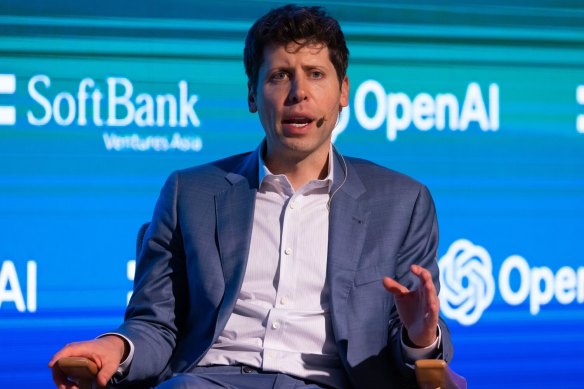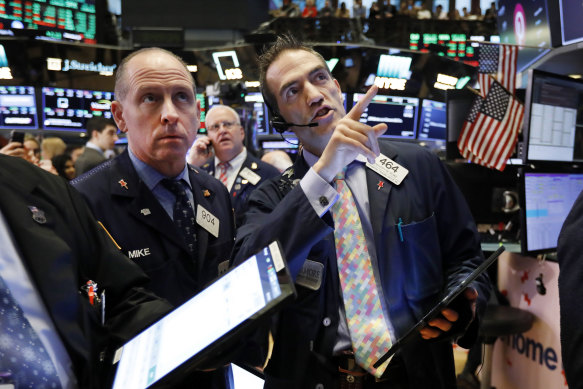Opinion
The $22 trillion question hanging over Wall Street
Stephen Bartholomeusz
Senior business columnistLate last week, artificial intelligence pioneer OpenAI closed the book on its $US6.5 billion ($9.5 billion) latest funding round, a raising reportedly massively oversubscribed. Its new investors are betting that the first mover in the scramble to develop generative AI will dominate the fledgling industry and its eventual profits.
In fact, with the capital raising based on a valuation of $US150 billion, the prospective investors are also effectively committing their funds in the hope that OpenAI will eventually become a multitrillion-dollar business.

OpenAI chief executive Sam Altman. Investors are betting that the company will dominate the fledgling industry and its eventual profits.Credit: Bloomberg
Among those who queued up to hand over their cheques were Thrive Capital (the venture capital firm headed by Josh Kushner, younger brother of Jared, Donald Trump’s son-in-law), which has committed more than $US1 billion.
Apple, Nvidia, Microsoft and the United Emirates-sponsored AI investment fund MGX are also apparently in that queue, which reportedly contained several billions of dollars more than OpenAI was seeking to raise.
Investors in early-stage, speculative technology investments look for opportunities that might provide at least 10 times their investment and often many times more.
At 10 times the valuation provided by the fundraising (which would be a very modest return by venture capital standards), OpenAI would be valued at $US1.5 trillion. As a point of reference, Facebook’s parent, Meta Platforms, is valued at about $US1.4 trillion.
A complication for the investors is that OpenAI has an unusual corporate structure, which it is considering changing.
It was originally conceived as a not–for-profit that would maximise the benefits of AI to humanity rather than the more conventional commercial goal of maximising profits.
The strain of funding development of its AI products, however, forced it to create a for-profit subsidiary in 2019, governed by the non-profit board. Profits were capped, in line with more optimistic venture capital aspirations, at a maximum of 100 times the investments made in the not-for-profit entity, into which Microsoft has already pumped about $US13 billion.
Tensions between the two tiers in OpenAI’s structure caused a blow-up at board level late last year, with its chief executive, Sam Altman, momentarily ousted and then reinstated after a staff revolt.
Restructuring the company into a conventional for-profit entity would obviously be appealing to the new investors and would provide an insight into their ambitions. If OpenAI was valued at more than 100 times their investment, it would, on the valuation provided by the latest fundraising, be worth more than $US15 trillion ($22 trillion)!

The hype around AI drove the share prices of the “Magnificent Seven” to record levels in July, but those prices have softened since.Credit: AP
The success of the raising and the escalating valuation implied – Open AI was valued at “only” $US86 billion in transactions earlier this year – suggests a conviction by some very large and astute investors that OpenAI can not only maintain its first-mover advantage but that the AI sector will be transformative, transforming their billions into trillions in the process.
OpenAI might be the industry leader at present – it has just released its latest models, which it claims can reason and can solve difficult maths, coding and science problems – but hard on its heels are mega-technology companies like Google, Meta, Amazon and even its own core investor, Microsoft, which has an AI development unit of its own.
Amazon also has a $US4 billion investment in OpenAI competitor, Anthropic, one of a broad range of AI start-ups – several launched by former OpenAI founders and one, xAI, backed by Elon Musk – scrambling to build their own generative AI models.
Each of the members of that formidable group of competitors is investing multiple billions of dollars every quarter in AI, with Google and Amazon both saying they will invest more than $US100 billion each over the next decade.
With the $US13.5 billion it has raised earlier, the $US6.5 billion from the current raising and, apparently, a $US5 billion debt facility it is negotiating, OpenAI would have access to about $US25 billion of capital.
It is investing more than $US5 billion a year (it could now be as much as $US7 billion) while incurring increasing losses as the cost of developing ever more complex models increases.
While it does have revenue – annualised, about $US3.4 billion this year and hopes of doubling that next year – the revenues being generated by AI aren’t yet anywhere close to justifying the scale of investments being made.

Joshua Kushner and partner Karlie Kloss. Kushner’s Thrive Capital is a big investor in Open AI.Credit: Bloomberg
That widening gap between massive investment and meagre returns that is causing some angst among shareholders in companies like Google and Amazon.
The hype around AI drove the share prices of the “Magnificent Seven” to record levels in July, but those prices have softened since as investors have started to focus on the maths of getting an appropriate return, within a reasonable timeframe, from investments that are huge and accelerating within a sector whose economics have yet to be defined.
There’s clearly a market for AI products at present, albeit a relatively small and unprofitable one today. The size and economics of the eventual market is, however, unknown and unknowable at this earliest phase in AI’s development and may remain a matter for speculation for some years to come.
The potential markets look vast, but whether a world transformed by AI could deliver profits commensurate with the risk capital sunk to create it is an impossible question to answer at present and will probably remain so for years (and trillions more dollars) to come.
Investors in early-stage, speculative technology investments look for opportunities that might provide at least 10 times their investment and often many times more.
The investments being made by OpenAI and its rivals will probably only be validated if, as could be the case, AI proves to be truly and radically transformative. It has to change the way the world lives and works and the companies have to be able to profit massively from the changes.
That’s a long term, risky and capital-devouring project, which means OpenAI will almost certainly have to raise a lot more capital if it is to survive to the point where the question marks over AI’s commercial potential are removed, if they are removed.
Self-evidently, if it has attracted more investment from Microsoft and brought Apple and Nvidia onto its register, while opening a conduit to Middle Eastern sovereign wealth funds, OpenAI will have access to the capital to compete with Google, Meta, Amazon and its own core funder, Microsoft, which has hedged its bets, so long as its backers – and their own investors – remain confident of eventual gigantic payoffs.
The Market Recap newsletter is a wrap of the day’s trading. Get it each weekday afternoon.